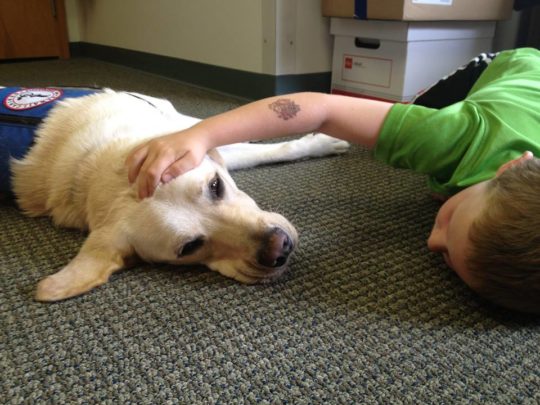Overview
A courthouse facility dog can contribute to the mission of a Children’s Advocacy Center (CAC) in many ways. Children are much more likely to relax if they enjoy interacting with a dog. And parents are happy to see that the CAC cares about their child’s welfare and is doing everything possible to make children comfortable and reduce their anxiety about being there.
Other benefits are that children may also provide better information about the incident during a forensic interview due to the presence of a loving dog, and CAC staff members serve as positive role models for the children through their kind treatment of the dogs.
In support of including facility dogs in forensic interviews review:
National Children’s Alliance – From the Director’s Desk
https://mailchi.mp/nca-online/caregiver-mental-health-993913?e=9227872230
and
Examining the Effects of a Service-Trained Facility Dog on Stress in Children Undergoing Forensic Interview for Allegations of Child Sexual Abuse
(2018) https://pubmed.ncbi.nlm.nih.gov/29533149/
See Where Courthouse Facility Dogs are Working for a list of dogs assisting at Child Advocacy Centers.

Courthouse facility dog Astro, bred and trained by Assistance Dogs of Hawaii, works at the Monarch Children’s Justice and Advocacy Center in Lacey, Washington.
A Neutral Title for the Dog
It’s best to use the term “courthouse facility dog” because it is a neutral title. Try to avoid calling your dog a “therapy dog,” “advocate dog,” or “emotional support animal,” because that can create legal issues should a case be litigated. Defense counsel could legitimately argue that the term “therapy dog” implies that the child is in fact a victim in need of therapy, and it is for the jury to decide if in fact the child was victimized. Using the term “advocate dog” implies that the dog is the child’s champion. Courts have found that the use of victim advocates can be prejudicial because of the appearance of vouching for credibility. See State V. Suka, 777 P2nd 240 (Haw.1989). Finally, do not call your dog a “service dog” because that term is reserved for dogs that assist individuals with disabilities. In one jurisdiction, a defense attorney accused the district attorney of committing the misdemeanor offense of trying to pass his facility dog off as a service dog.
Who Will Be the Handler
The courthouse facility dog will need to have a primary handler who is willing to accept full responsibility for the dog’s welfare. This primary handler, usually a forensic interviewer or a victim advocate, will be the person at the CAC who will use the dog most often. In addition to the primary handler, one or more secondary handlers will need to be trained to handle the dog correctly in order to provide more opportunities for the dog to assist your clients. Most forensic interviewers limit their contact with children to the time spent during an interview session to preserve the interview as a clinical and objective experience should they have to testify in court. In this situation, having a victim advocate as the secondary handler would allow for the child to spend more time with the dog after the interview takes place.
Acquainting Parents and Children with the Courthouse Dog® Program
A sign in your lobby should announce the presence of a courthouse facility dog at your CAC. A photo of the dog, along with his handlers, will be a good first step toward introducing the dog to families. The facility dog should wear his identifying vest whenever he is on duty at the center. This will help differentiate him from other working dogs (such as police dogs) that the clients may have previously encountered.

